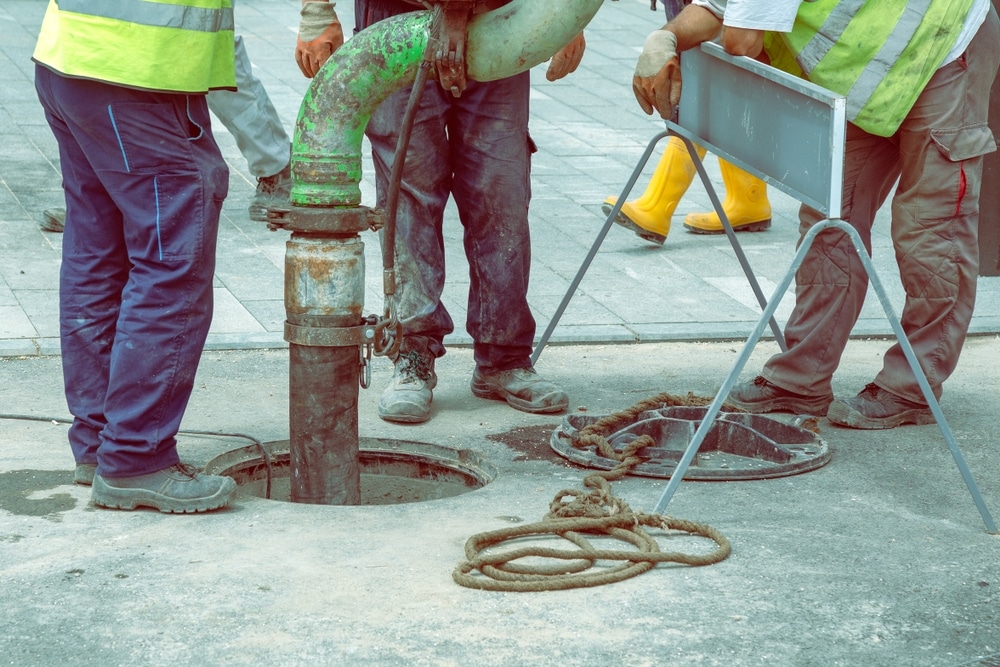Septic Tank Services in Washington, DC
"*" indicates required fields
Septic Tank Treatment
If you work in a building that doesn’t have access to a city sewer main, there’s a very good chance that you have a septic tank somewhere on the property. At least, we certainly hope you do. If you do happen to have a septic tank serving your commercial building, you’re going to want to make sure that it is pumped out frequently. Call Magnolia Plumbing, Heating & Cooling today for all of your septic tank pumping needs. We offer septic tank pumping services.
Magnolia Plumbing, Heating & Cooling provides septic tank pumping services in Washington, DC and the surrounding areas.

Septic Tank Pumping
Septic tanks are closed systems, which mean they have no way to get rid of the waste that flows into them. They serve as simple holding tanks, until a truck can come by and pump out the waste for safe disposal. Septic tank pumping is actually quite simple. A waste transport truck pulls up to the hookup for the tank and attaches a hose. A pump is then activated, which pumps out all of the waste currently in the tank. Then, the truck disconnects and drives off to a waste treatment plant.
Septic Tank Cleaning
If you’re asking this question, you probably aren’t aware what a septic tank actually does. If you really don’t want to have your septic tank pumped out every month or two, though, let us explain what can happen. First, a tank that is allowed to fill up completely will start backing up into the building; this causes sewage to contaminate pipes in the building, some of which may be designed to carry fresh water. This will necessitate that all water pipes be cleaned out for sanitary purposes after the backup is remedied.
At the same time, the pressure buildup from all the sewage can actually cause the septic tank to crack. This sewage leaks into the surrounding ground, and commonly causes it to rise to the surface. So, if you don’t get your septic tank pumped out often enough, you could actually wind up with a fetid, festering swamp of sewage somewhere on your property.
On top of that, the cracked septic tank will now need to either be repaired or replaced, depending on how severe the crack is. This will typically cost a hefty amount of money to repair, which could have been avoided. The pipes leading to the septic tank could also burst, spilling sewage into other areas, including the building itself.
So, it is better for you, your building, and everyone in it to have your septic tank pumped as often as your technician says you need to. It will save time, money, and will just be better for everyone’s overall health.
Septic Tank FAQs
If you are not in emergency mode you can reach out to your local health department and request the location of your septic tank. Your local health department should have this information on record. Unfortunately most people are only in search of the tank when they are in emergency mode and can’t wait for the health department. First, try and locate where the main sewer exits the building structure. If you locate this exit point, go outside and take a probing rod and start probing in the general area anywhere between 5’ – 15’ from the building structure. Most tanks are only a couple of feet below the grounds surface. If the above mentioned options fail, you will most likely have to spend some money with a plumbing/septic contractor to locate the tank. Most plumbing/septic contractors are capable of using locating equipment to find the tank.
This is a great question and the answer is not the same for everyone. There are charts that take into account the capacity of the tank, the number of fixtures in the home, and the number of people living in the household. These charts are pretty good and can result in excellent guidelines to go by. Others say that having it pumped once every three years is the best rule of thumb. The best answer that can be used for every tank is that the tank should be pumped when the top layer of scum/grease and the bottom layer of sludge/solids exceed 33% of the total liquid volume of the tank. The wastewater in every septic tank is separated into (3) three distinct layers. All heavy solids will fall to the bottom and this layer is referred to as sludge while all lighter material such as grease will float to the top and this is referred to as the scum layer. The rest of the wastewater will remain in the middle and this layer is referred to as the clear zone. When the layer of scum and sludge added together surpass 33% of the total liquid depth, it is time to have the tank pumped. This can only be determined when a competent contractor uses a sludge judge, dipstick, or similar tool to take these measurements.
Unless the tank is being pumped by a plumbing/septic tank contractor it should always be holding wastewater. The liquid level should be at the invert (bottom) of the outlet line. If the liquid level is below this point, there is a chance that the tank itself has been compromised and is actually leaking into the ground. This should be inspected by a qualified plumbing/septic contractor. If the liquid level is above the invert of the outlet line, it is an indication of a problem with a downstream component.
This is another great question. Most systems have inspection ports, 3″–4″ inspection pipes protruding out of the ground at the inlet and outlet of the septic tanks. The tank should never be pumped from these ports. Why? Because the tank will never be fully evacuated this way. Some tanks are single chamber tanks and some are double chamber tanks. The only way to evacuate the tank properly is to excavate (if the lids are below ground) and remove the manhole covers and pump all contents from the tank.
Maybe, maybe not. Some septic systems are very elaborate and have many different components, such as pump/dosing tanks, aeration tanks, trash tanks, sand filters, leaching/drain fields, etc. When a sewer line backs up, it could be a problem between the house and the septic tank, or it could be a component beyond the tank. There is no way to diagnose this without having a qualified technician at the site.
We Provide Comprehensive Septic Tank Pumping Services throughout Washington, DC
No matter what your septic tank pumping needs are, we can help you out. If you need septic tank pumping services, call Magnolia Plumbing, Heating & Cooling today to schedule an appointment with one of our expert technicians.
We're ready to help.
We called Magnolia to help us with an emergency situation in our home.
Mario was incredibly professional and clean while working. He was kind and made sure we fully understood what was happening each step of the way. I would absolutely use this company again for future needs and highly recommend Mario!Magnolia was great. They were extremely professional and honest.
Came in and had the job done quickly – moved all my appliances for me, wore booties, and even put down drop cloths. I couldn’t have asked for anything more. I highly recommend them to anyone looking for an exceptional plumbing company. Thank you Magnolia!Magnolia plumbing was efficient and cost saving with replacing my water heater.
They made sure I checked the warranty of my tank so I did not unnecessarily purchase a new tank, and mine was still under warranty. I was very pleased and thankful for the fantastic work.I needed to have several plumbing repairs handled
at my place of residence. So I contacted Magnolia Plumbing. They have always been professional and knowledgeable. Last week I have Duane Cunningham arrive and he was very polite and professional and very efficient. He explained all of what would be needed to perform the repairs and he performed each task timely and effectively. Magnolia Plumbing Heating and Cooling will always be my 1st choice.Magnolia is full service,
including air conditioning, heating, plumbing and subcontracting for flues and chimney lining. I had a very old gas water heater and they replaced it within 2 days from doing an audit and even when I requested a switch to electric from gas at the last minute it was no problem. Pasquale is a professional and took care of every aspect, replaced leaking pipes, brought my gas boiler flue up to code and installed a high grade water heater; their pricing is very competitive.

